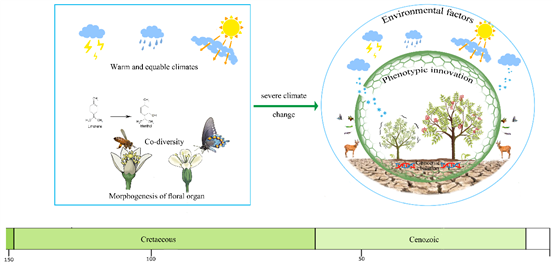The Research Office of Tropical Spicy Beverage Germplasm Resources, Spice and Beverage Research Institute, Chinese Academy of Tropical Agricultural Sciences has made important progress in the research of genome evolution and adaptive evolution of Chinese prickly ash. On the basis of realizing high-quality genome splicing and chromosome anchoring of Zanthoxylum bungeanum and Zanthoxylum bungeanum, the research team revealed the genetic basis of unique flower organ degeneration, phytohormone synthesis and adaptive phenotype innovation of Zanthoxylum bungeanum, indicating that the genome evolution and phenotype innovation of Zanthoxylum bungeanum are consistent with the harsh ecological factors of the late Cenozoic era, especially the cold and/or dry climatic conditions. The research results provide important insights into the adaptive evolution mechanism behind the diversity evolution and phenotype innovation of Zanthoxylum bungeanum, and have broad significance for the improvement of plant protection and utilization and adaptive evolution theory under extreme environmental changes in the new geological period.

Diagram of adaptive evolution characteristics of Zanthoxylum bungeanum
Zanthoxylum armatum and Zanthoxylum bungeanum are spice crops of the genus Zanthoxylum of Rutaceae. They are known as "Chinese Pepper" because of their extensive application in traditional Chinese medicine and Chinese diet. Zanthoxylum bungeanum has high economic value and strong adaptability. With a planting area of more than 20 million mu, it is the largest woody spice crop in China and has important value in serving the national rural revitalization strategy. In addition, the unusually complex genome, degenerated reproductive strategy and unique adaptive phenotype of Zanthoxylum bungeanum also endow it with unique value in the study of plant adaptive evolution.
Based on the strategy of high depth sequencing, Canu assembly and "removing redundancy while clustering", the research team assembled the genomes of Zanthoxylum armatum and Zanthoxylum bungeanum with the best continuity and integrity. The analysis of genome evolution shows that the dramatic genome rearrangement and two full genome replications of Zanthoxylum bungeanum have resulted in a large genome (~4.5G), a high ratio of repetitive sequences (>82%), a high heterozygosity (>6%) and a large number of chromosomes (2n=4 ×= 132). Combined with metabonomic, genomic evolution and transcriptome analysis, the genetic basis of unique floral organ degeneration, biosynthesis of ephedrine and other phytohormones, and environmental adaptive phenotype innovation of Zanthoxylum bungeanum were revealed. These phenotypes are significantly different from the phenotypic innovation of pollinator coevolution in the classical evolutionary theory of angiosperms (Darwin's "hate puzzle"). Further, based on the adaptive difference between Zanthoxylum bungeanum and Zanthoxylum bungeanum, the subgenome preference of gene expression and the accumulation difference of flavonoids, it is revealed that the genome evolution and phenotypic innovation of Zanthoxylum bungeanum are consistent with the harsh ecological factors of the late Cenozoic era, especially the cold and/or dry climate conditions, indicating that the adaptive evolution of Zanthoxylum bungeanum bungeanum is consistent with the genome evolution and environmental driving. The results can provide data and theoretical reference for molecular breeding and plant evolution of Zanthoxylum bungeanum.
The research results were published in the Plant Biotechnology Journal as "The complex genome and adaptive evolution of polyploid Chinese pepper (Zanthoxylum armatum and Zanthoxylum bungeanum) 。 Zhu Shu, researcher Hao Chaoyun of our institute, professor Jin Shuangxia of Huazhong Agricultural University, and president of Jiangsu Jinjiaohong Spice Science and Technology Research Institute, is the co corresponding author of the paper, Hu Lisong and Fan Rui, associate researchers, and Xu Zhongping, postdoctoral fellow of Huazhong Agricultural University, is the co first author. This research has been supported by the National Natural Science Foundation of China, the scientific research project of Hainan Academician Innovation Platform, and the gene breeding project of Jiangsu Jinjiaohong Spice Science and Technology Research Institute.


